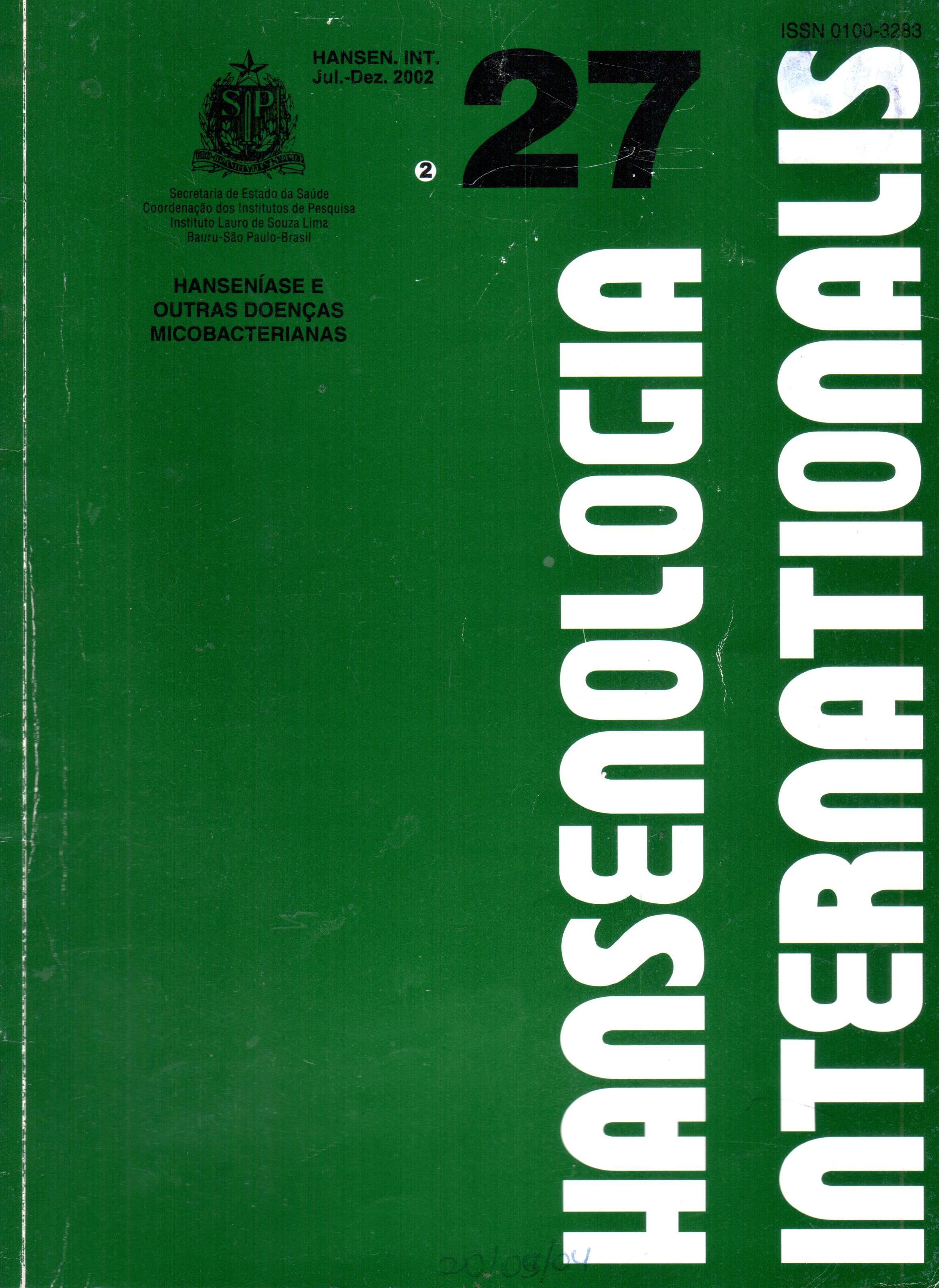Resumen
Objetivando determinar a influência do período de evolução prévio ao diagnóstico na presença de incapacidades detectadas no exame inicial de pacientes portadores de hanseníase multibacilar, 100 pacientes (18% BB; 47% BL; e 35% LL) foram perguntados, na anamnese, sobre o período de sintomas/sinais da enfermidade anteriormente ao primeiro exame. Mais de 2/3 do pacientes (71%) tiveram o diagnóstico em um período de tempo superior a 6 meses de duração da enfermidade (55% em período superior a 1 ano de evolução). Os pacientes foram avaliados em relação a incapacidades físicas no momento do diagnóstico através do grau de incapacidade antes do tratamento (GIAT). Quanto às incapacidades presentes no diagnóstico, 44% apresentavam GIAT = 0; 33% apresentavam GIAT = 1;22% apresentavam GIAT = 2; e 1% apresentava GIAT =3. O período de evolução previamente ao diagnóstico foicorrelacionado com o GIAT (coeficiente de correlação =0,243440135),e a análise de variação pelo teste deKruskal-Wallis resultou em p = 0,012606; foiestatisticamente significativo mesmo quando o tempo deevolução prévio foi agrupado em < 6 meses e maior que6 meses (p = 0,012613), e quando agrupado de 12 em12 meses (p = 0,019428). Pacientes com maiores temposde evolução antes do diagnóstico apresentaram maioresgraus de incapacidade antes do tratamento. Estes dadosdemonstram a importância do diagnóstico precoce naprevenção de incapacidades relacionadas à hanseníase.
Citas
2 CHEN X. S., LI W. Z., JIANG C. e YE G. Y. Leprosy in China: delay in the detection of cases. Ann Trop Med Parasitol 2000, 94 (2): 181-188.
3 CROFT R. P., RICHARDUS J. H., NICHOLLS P. G. e SMITH W. C. Nerve function impairment in leprosy: design, methodology and intake status of a prospective cohort study of 2664 new leprosy cases in Bangladesh ( The Bangladesh Acute Nerve Damage Study). Lepr Rev 1999, 70 (2): 140 —159.
4 GUIA DE CONTROLE DA HANSENÍASE / Ministério da Saúde. Fundação Nacional de Saúde. Centro Nacional de Epidemiologia. Coordenação Nacional de Dermatologia Sanitária. Segunda edição, Brasilia, 1994, 156 p.
5 JOB C. K. Nerve damage in leprosy. Int J Lepr 1989, 57 (2): 532-539.
6 LOCKWOOD D. N. e REID A. J. The diagnosis of leprosy is delayed in the United Kingdom. Q J M 2001, 94 (4): 207-212.
7 MEIMA A., SAUNDERSON P. R., GEBRE S., DESTA K., VAN OORTMARSSEN G. J. e HABBEMA J. D. Factors associated with impairments in new leprosy patients: the AMFES cohort. Lepr Rev 1999, 70 (2): 189-203.
8 MEKLAFI G. A e AL-QUBATI Y. Retrospective analysis of 194 leprosy cases in Republic of Yemen. Indian J Lepr 1996, 68 (3): 227-234.
9 NATIONS S. P, KATZ J. S., LYDE C. B. e BAROHN R. J. Leprous neuropathy: an American perspective. Semin Neurol 1998, 18 (1): 113-124.
10 OO1 W. W. e MOSCHELLA S. L. Update on leprosy in immigrants in the United States: status in the year 2000. Clin Infect Dis 2001, 32 (6): 930-937.
11 PEARSON J. M. H. The evaluation of nerve damage in leprosy. Lepr Rev 1982, 53: 119-130.
12 PIMENTEL M. I. F. Neurites na hansenfase: significado de parâmetros clínicos e epidemiológicos na indução e agravamento das incapacidades físicas em pacientes multibacilares. Tese de Doutorado. Universidade Federal do Rio de Janeiro. Rio de Janeiro, Novembro de 1998, 99 p.
13 PONNIGHAUS I. M., BOERRIGTER G., FINE P. E. M, PONNIGHAUS J. M. e RUSSELL J. Disabilities in leprosy patients ascertained in a total population survey in Karonga District, Northern Malawi. Lepr Rev 1990, 61:366-374.
14 RAO P S., SUBRAMANIAN M. e SUBRAMANIAN G. Deformity incidence in leprosy patients treated with multidrug therapy. Indian J Lepr 1994, 66 (4): 449-415.
15 REDDY B. N. e BANSAL R. D. An epidemiological study of leprosy disability in a leprosy endemic rural population of Pondicherry (South India). Indian J Lepr 1984, 56 (2): 191-199.
16 RICHARDUS J. H., FINLAY K. M., CROFT R. P. e SMITH W. C. S. Nerve function impairment in leprosy at diagnosis and at completion of MDT a retrospective cohort study of 786 patients in Bangladesh. Lepr Rev 1996, 67: 297-305.
17 RICHARDUS J. H., MEIMA A, CROFT R. P. e HABBEMA J. D. Case detection, gender and disability in Bangladesh: a trend analysis. Lepr Rev 1999, 70 (2): 160-173.
18 RIDLEY D. S. e JOPLING W. H. Classification of leproy according to immunity. A five-group system. Int. Lepr 1966, 34 (3): 255-272.
19 ROBERTSON L. M., NICHOLLS P. G. e BUTLIN R. Delay in presentation and start of treatment in leprosy: experience in an out-patient clinic in Nepal. Lepr Rev 2000, 71 (4): 511-516.
20 SADEGHI P, DUPREE M. e CARLSON J A Delay in diagnosis: indeterminate leprosy presenting with rheumatic manifestations. J Cutan Med Surg 2000, 4 (1): 26-29.
21 SAUNDERSON P. The epidemiology of reactions and nerve damage. Lepr Rev 2000, 71 (Suppl): 5106-S110.
22 SCHIPPER A, LUBBERS W. J. HOGEWEG M. e DE SOLDENHOFF R. Disabilities of hands, feet and eyes in newly diagnosed leprosy patients in eastern Nepal. Lepr Rev 1994, 65 (3): 239-247.
23 SMITH W. C. S., ANTIN U. S. e PATOLE A R. Disability in leprosy: a relevant measurement of progress in leprosy control. Lepr Rev 1980, 51: 155-166.
24 SRINIVASAN H. Newer tasks for leprosy workers. Indian J Lepr 1990, 62 (4): 409-415.
25 SRINIVASAN H. Not by chemotherapy alone. Indian J Lepr 1994, 66 (2): 209-221.
26 WITTENHORST B., VREE M. L., TEN HAM P. B. e VELEMA J. P. The National Leprosy Control Programme of Zimbabwe: a data analysis, 1983 —1992. Lepr Rev 1998, 69 (1): 46 — 56.
27 WU X. S., NING Y., SHI L. e YANG J. W. An epidemiological analysis of leprosy from 1951 —1996 in Sichuan. Indian J Lepr 2000, 72 (2): 215- 226.

Esta obra está bajo una licencia internacional Creative Commons Atribución 4.0.
